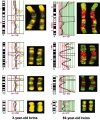File:Epigenetics - monozygous twins.jpg: Difference between revisions
No edit summary |
mNo edit summary |
||
| (One intermediate revision by one other user not shown) | |||
| Line 12: | Line 12: | ||
"...We found that, although twins are epigenetically indistinguishable during the early years of life, older monozygous twins exhibited remarkable differences in their overall content and genomic distribution of 5-methylcytosine DNA and histone acetylation, affecting their gene-expression portrait. These findings indicate how an appreciation of epigenetics is missing from our understanding of how different phenotypes can be originated from the same genotype." | "...We found that, although twins are epigenetically indistinguishable during the early years of life, older monozygous twins exhibited remarkable differences in their overall content and genomic distribution of 5-methylcytosine DNA and histone acetylation, affecting their gene-expression portrait. These findings indicate how an appreciation of epigenetics is missing from our understanding of how different phenotypes can be originated from the same genotype." | ||
===Reference=== | |||
{{#pmid:16009939}} | |||
====Copyright==== | |||
(2005) National Academy of Sciences, U.S.A | |||
{{Footer}} | |||
[[Category:Molecular]] [[Category:Epigenetics]] | |||
[[Category:Molecular]] | |||
Latest revision as of 10:16, 20 March 2018
DNA methylation in young and old monozygous twins
Chromosome regions with differential DNA methylation in young and old monozygous twins.
Significant DNA methylation changes are indicated as thick red and green blocks in the ideograms.
The 3-year-old twins have a very similar DNA methylation (yellow).
The 50-year-old twin pair shows abundant changes in the pattern of DNA methylation (green=hypermethylation and red=hypomethylation).
"...We found that, although twins are epigenetically indistinguishable during the early years of life, older monozygous twins exhibited remarkable differences in their overall content and genomic distribution of 5-methylcytosine DNA and histone acetylation, affecting their gene-expression portrait. These findings indicate how an appreciation of epigenetics is missing from our understanding of how different phenotypes can be originated from the same genotype."
Reference
Fraga MF, Ballestar E, Paz MF, Ropero S, Setien F, Ballestar ML, Heine-Suñer D, Cigudosa JC, Urioste M, Benitez J, Boix-Chornet M, Sanchez-Aguilera A, Ling C, Carlsson E, Poulsen P, Vaag A, Stephan Z, Spector TD, Wu YZ, Plass C & Esteller M. (2005). Epigenetic differences arise during the lifetime of monozygotic twins. Proc. Natl. Acad. Sci. U.S.A. , 102, 10604-9. PMID: 16009939 DOI.
Copyright
(2005) National Academy of Sciences, U.S.A
Cite this page: Hill, M.A. (2024, May 24) Embryology Epigenetics - monozygous twins.jpg. Retrieved from https://embryology.med.unsw.edu.au/embryology/index.php/File:Epigenetics_-_monozygous_twins.jpg
- © Dr Mark Hill 2024, UNSW Embryology ISBN: 978 0 7334 2609 4 - UNSW CRICOS Provider Code No. 00098G
File history
Click on a date/time to view the file as it appeared at that time.
| Date/Time | Thumbnail | Dimensions | User | Comment | |
|---|---|---|---|---|---|
| current | 11:53, 1 July 2010 |  | 450 × 540 (78 KB) | S8600021 (talk | contribs) | ==DNA methylation in young and old monozygous twins== Chromosome regions with differential DNA methylation in young and old monozygous twins. Significant DNA methylation changes are indicated as thick red and green blocks in the ideograms. The 50-year |
You cannot overwrite this file.
File usage
The following page uses this file: